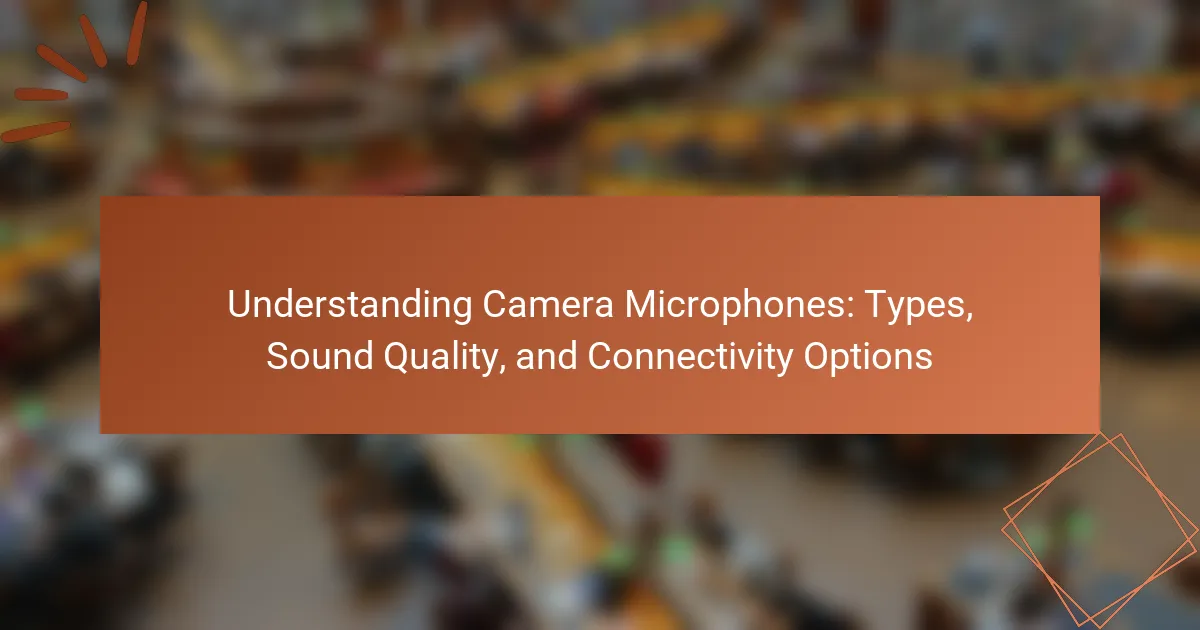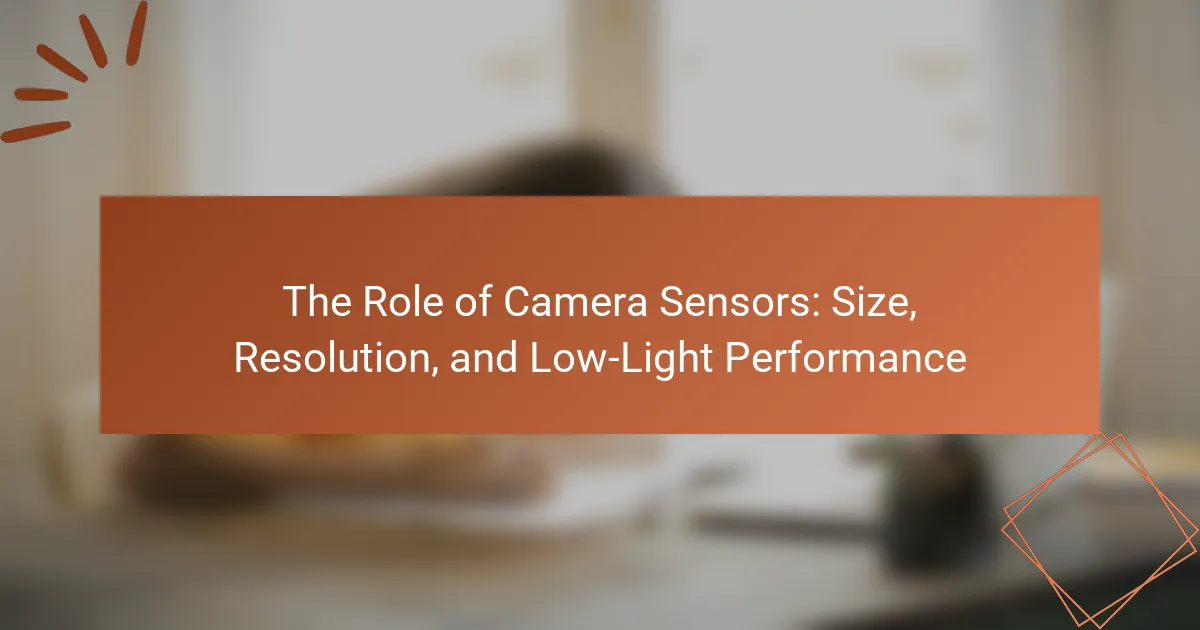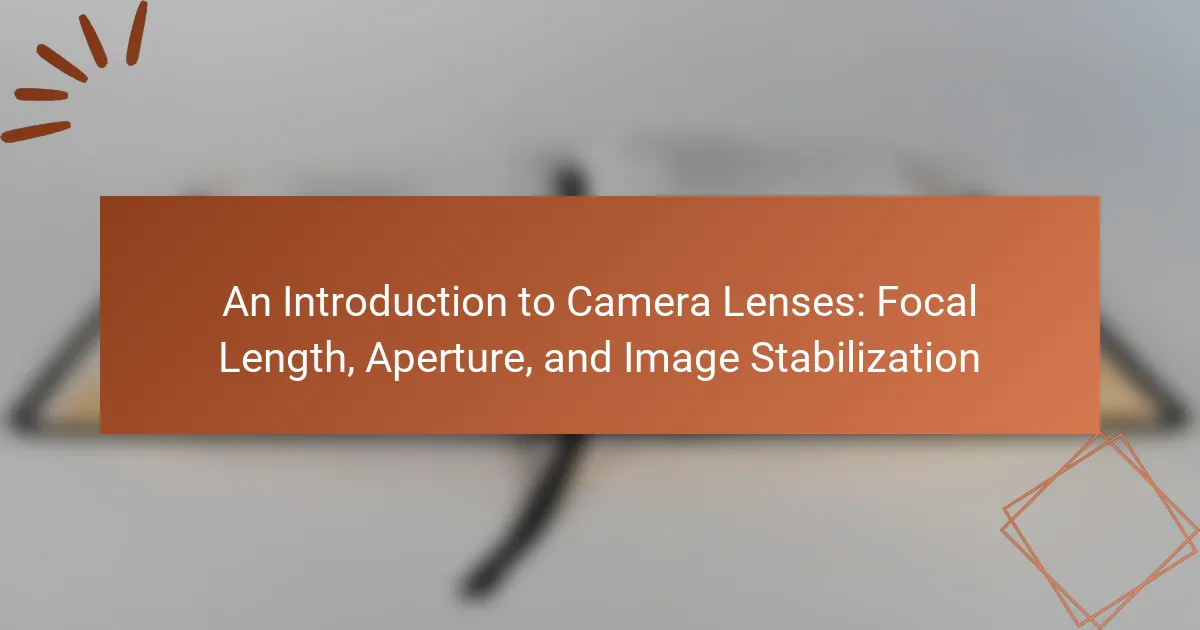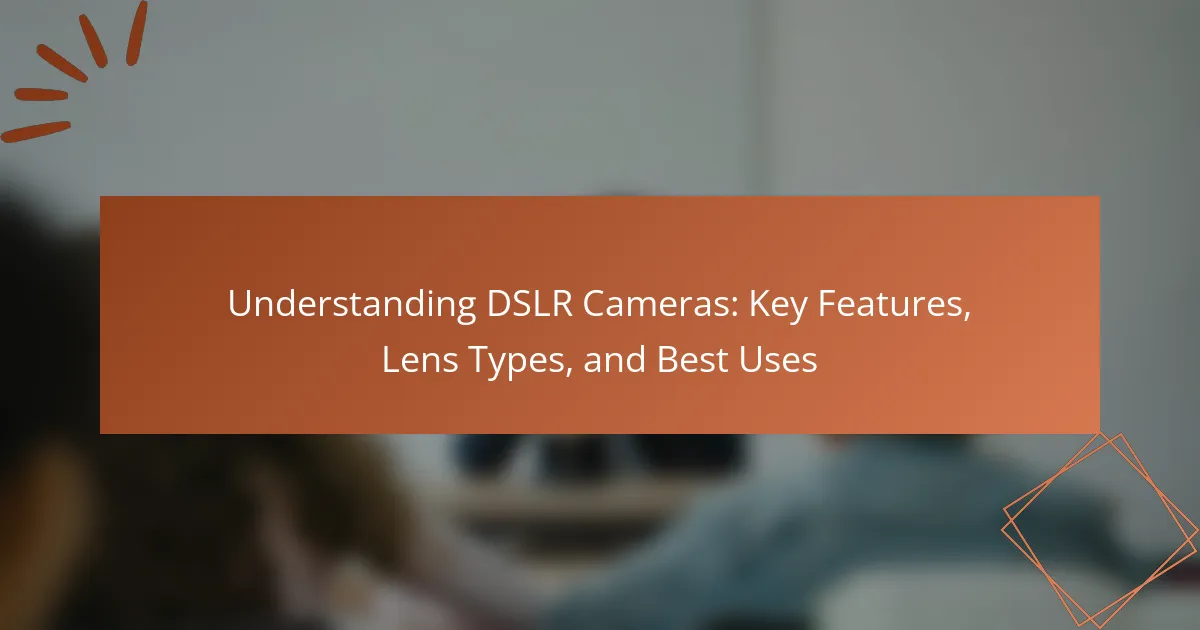The article focuses on selecting the right camera bag, emphasizing three critical factors: protection, size, and organization features. It outlines the importance of safeguarding camera equipment with padded compartments and weather-resistant materials. The article also discusses how the bag’s size should accommodate necessary gear without being cumbersome. Additionally, it highlights the significance of organization features, such as adjustable dividers and external pockets, to enhance accessibility. Different styles of camera bags, including backpacks, shoulder bags, and hard cases, are examined for their unique benefits and suitability for various photography needs.
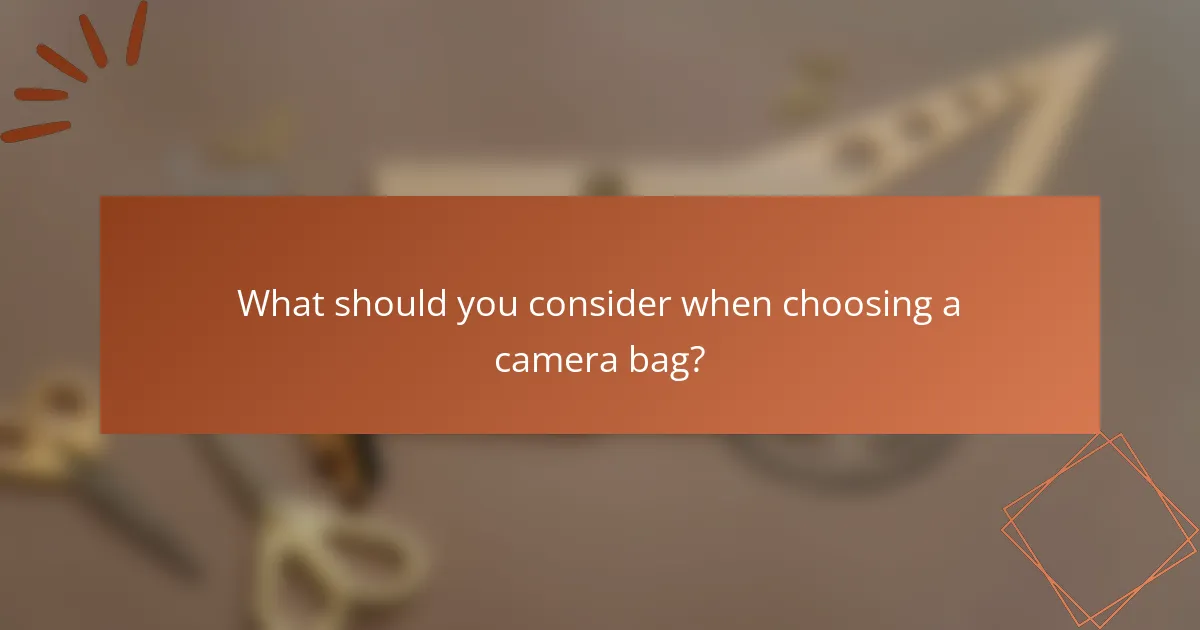
What should you consider when choosing a camera bag?
When choosing a camera bag, consider protection, size, and organization features. Protection is essential to safeguard your equipment from damage. Look for bags with padded compartments and weather-resistant materials. Size should accommodate your camera and accessories without being overly bulky. Check the bag’s dimensions against your gear. Organization features like adjustable dividers help keep items accessible and secure. Additionally, consider comfort features such as padded straps and back support for ease of transport. Lastly, evaluate the bag’s style and compatibility with your photography needs.
How does protection play a role in selecting a camera bag?
Protection is a critical factor in selecting a camera bag. A camera bag must safeguard equipment from physical damage, moisture, and dirt. High-quality padding and durable materials enhance protection. Waterproof or water-resistant features prevent damage from rain or spills. Reinforced zippers and seams add structural integrity. Many bags include customizable dividers to secure individual components. Protection ensures that valuable gear remains intact during transport. Research shows that equipment can be damaged by impacts, with repair costs averaging hundreds of dollars. Therefore, investing in a protective camera bag is essential for preserving equipment longevity.
What materials offer the best protection for camera gear?
The best materials for protecting camera gear include padded nylon, ballistic nylon, and EVA foam. Padded nylon provides cushioning and is water-resistant. Ballistic nylon is known for its durability and resistance to abrasions. EVA foam is lightweight and offers excellent shock absorption. These materials help safeguard camera equipment from impacts, moisture, and dust. High-quality camera bags often combine these materials for optimal protection.
How do weather-resistant features enhance protection?
Weather-resistant features enhance protection by preventing water, dust, and debris from damaging equipment. These features often include waterproof materials, sealed zippers, and reinforced stitching. Waterproof materials can withstand heavy rain, ensuring that contents remain dry. Sealed zippers block moisture from entering through openings. Reinforced stitching adds durability, preventing wear and tear over time. According to a study by the Camera and Imaging Products Association, bags with weather-resistant features significantly reduce the risk of equipment failure in adverse conditions. This combination of attributes helps maintain the integrity and functionality of sensitive gear.
Why is size important when choosing a camera bag?
Size is important when choosing a camera bag because it affects the bag’s capacity and protection. A properly sized camera bag will securely fit your camera gear, preventing movement during transport. If the bag is too large, gear may shift and become damaged. Conversely, a bag that is too small can lead to overcrowding, risking damage to both the equipment and the bag itself. Additionally, the size of the bag influences portability. A compact bag is easier to carry and navigate in crowded spaces. Size also determines organizational features, such as compartments for lenses and accessories. Proper organization helps in quick access to gear, enhancing shooting efficiency. Therefore, selecting the right size ensures both protection and functionality for your camera equipment.
What are the different sizes of camera bags available?
Camera bags are available in various sizes to accommodate different needs. Common sizes include small, medium, large, and extra-large. Small camera bags are designed for compact cameras and minimal gear. Medium bags can hold a DSLR or mirrorless camera with one or two lenses. Large bags typically fit a DSLR or mirrorless camera with multiple lenses and accessories. Extra-large bags are intended for professional photographers, accommodating multiple cameras and extensive gear. This sizing helps photographers choose a bag that meets their specific storage and transport requirements.
How do you determine the right size for your equipment?
To determine the right size for your equipment, first measure the dimensions of your camera and accessories. This includes the camera body, lenses, and any additional gear. Next, compare these measurements to the internal dimensions of potential camera bags. Ensure there is enough space for all items, allowing for padding and organization. Additionally, consider the bag’s intended use, such as travel or outdoor photography, which may require different sizes. Many manufacturers provide sizing guidelines based on common equipment setups. Checking user reviews can also provide insights on fit and practicality.
What organization features should you look for in a camera bag?
Look for multiple compartments in a camera bag for effective organization. These compartments help separate camera gear, lenses, and accessories. Padded dividers are essential for protecting equipment from damage. Additionally, external pockets are useful for storing smaller items like memory cards and batteries. A dedicated laptop sleeve can be beneficial for transporting a laptop alongside camera gear. Adjustable dividers allow customization based on your specific gear needs. Some bags also feature quick-access pockets for easy retrieval of frequently used items. These organization features enhance convenience and efficiency during photography sessions.
What types of compartments are essential for organization?
Essential compartments for organization in a camera bag include padded dividers, accessory pockets, and lens slots. Padded dividers protect camera gear and allow for customizable layouts. Accessory pockets store smaller items like batteries and memory cards. Lens slots provide secure storage for additional lenses. These compartments enhance accessibility and prevent damage to equipment. Proper organization improves efficiency during shoots and travel.
How can customizable dividers improve organization?
Customizable dividers can significantly improve organization within camera bags. They allow users to create tailored compartments that fit specific equipment sizes. This prevents gear from shifting during transport, reducing the risk of damage. Customizable dividers also enable efficient access to equipment, saving time when setting up for shoots. According to a study by the Journal of Organizational Behavior, personalized organization systems enhance productivity and reduce stress. This evidence supports the effectiveness of customizable dividers in maintaining an orderly camera bag.
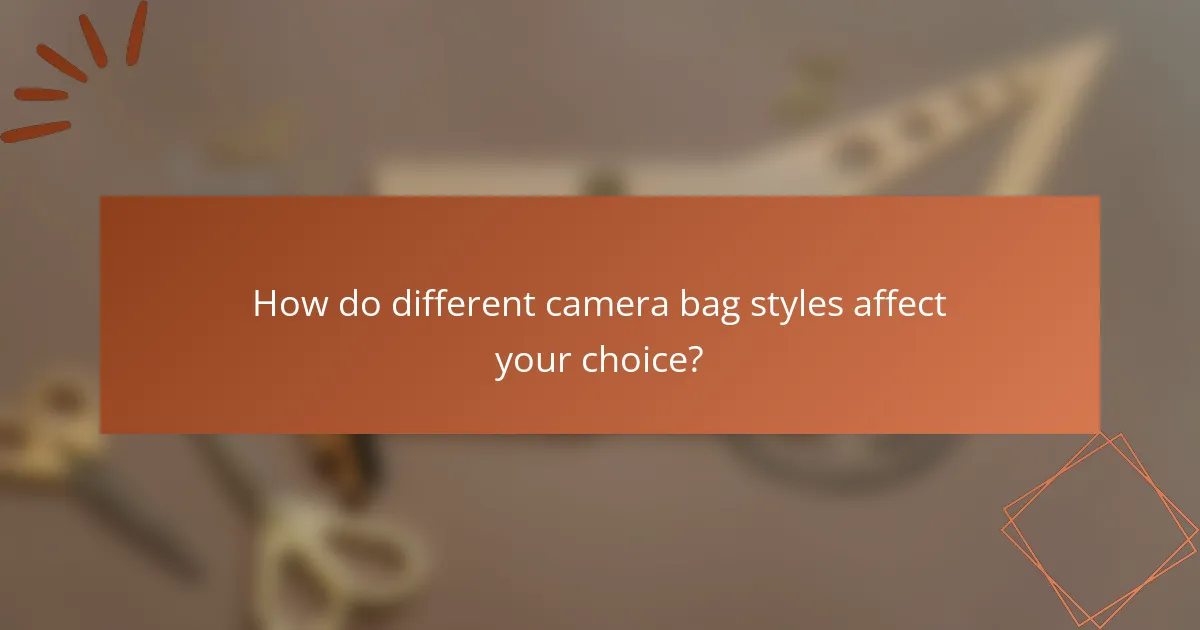
How do different camera bag styles affect your choice?
Different camera bag styles significantly influence your choice based on protection, size, and organization features. Each style offers unique attributes that cater to specific needs. For instance, a backpack style provides even weight distribution and ample storage. This is ideal for outdoor photographers requiring hands-free mobility. Conversely, a shoulder bag style offers quick access to gear, making it suitable for event photography. A hard case provides maximum protection against impacts, which is vital for delicate equipment. Additionally, the size of the bag impacts portability and storage capacity. Smaller bags are lightweight and easy to carry but may limit gear capacity. In contrast, larger bags can accommodate more equipment but may be cumbersome. Overall, the choice of camera bag style directly affects functionality and user experience.
What are the main types of camera bags available?
The main types of camera bags available include shoulder bags, backpacks, sling bags, and hard cases. Shoulder bags are designed for quick access and easy carrying. Backpacks offer more storage and distribute weight evenly. Sling bags provide a balance between convenience and capacity. Hard cases offer maximum protection for equipment during travel. Each type serves different needs based on the photographer’s style and equipment.
What are the benefits of using a backpack style camera bag?
Backpack style camera bags offer several benefits for photographers. They provide hands-free convenience, allowing easy movement while carrying equipment. The weight distribution is balanced across both shoulders, reducing strain during long shoots. These bags typically have padded compartments for camera gear, enhancing protection from impacts. Many models feature customizable dividers for organized storage of lenses and accessories. Backpack style bags often include additional pockets for personal items, enhancing functionality. They are designed for outdoor use, often made from weather-resistant materials. This design helps keep equipment safe from the elements.
What are the advantages of a messenger style camera bag?
Messenger style camera bags offer several advantages for photographers. They provide easy access to gear, allowing quick retrieval and storage. Their design typically includes adjustable straps for comfort during transport. Many messenger bags feature padded compartments, ensuring equipment protection. They often have a sleek, urban appearance, suitable for casual environments. Additionally, these bags usually allow for organization of various accessories. Some models include weather-resistant materials, offering protection against the elements. Overall, messenger style camera bags combine functionality with style, catering to the needs of modern photographers.
How does the style of a camera bag influence usability?
The style of a camera bag significantly influences usability by affecting accessibility, comfort, and organization. A backpack style allows for even weight distribution, making it easier to carry for long periods. Sling bags offer quick access to gear, beneficial for photographers needing to capture moments swiftly. Messenger bags provide a balance of style and functionality, allowing for easy access while on the go. Additionally, the internal layout and compartmentalization of a bag style dictate how well equipment is organized and protected. Well-designed bags reduce the risk of damage during transport, enhancing overall usability.
What features enhance accessibility in different bag styles?
Accessibility in different bag styles is enhanced by features such as adjustable straps, quick-access pockets, and lightweight materials. Adjustable straps allow users to customize fit, improving comfort and ease of use. Quick-access pockets enable fast retrieval of items, which is crucial for photographers needing immediate access to equipment. Lightweight materials reduce strain when carrying the bag, making it easier to transport. Additionally, bags with wide openings facilitate easier access to contents. Zippered compartments can secure items while still providing easy access. Lastly, bags designed with ergonomic shapes can help distribute weight evenly, enhancing overall accessibility. These features collectively contribute to a more user-friendly experience when using various bag styles.
How does the weight distribution affect comfort during use?
Weight distribution significantly affects comfort during use. Proper weight distribution minimizes strain on the body. It ensures that the weight is evenly spread across the shoulders and back. This balance prevents discomfort and fatigue during prolonged carrying. Uneven weight distribution can lead to muscle tension and pain. Studies show that balanced load reduces the risk of injury. For example, a well-designed camera bag distributes weight across multiple points. This design enhances user comfort during extended use.
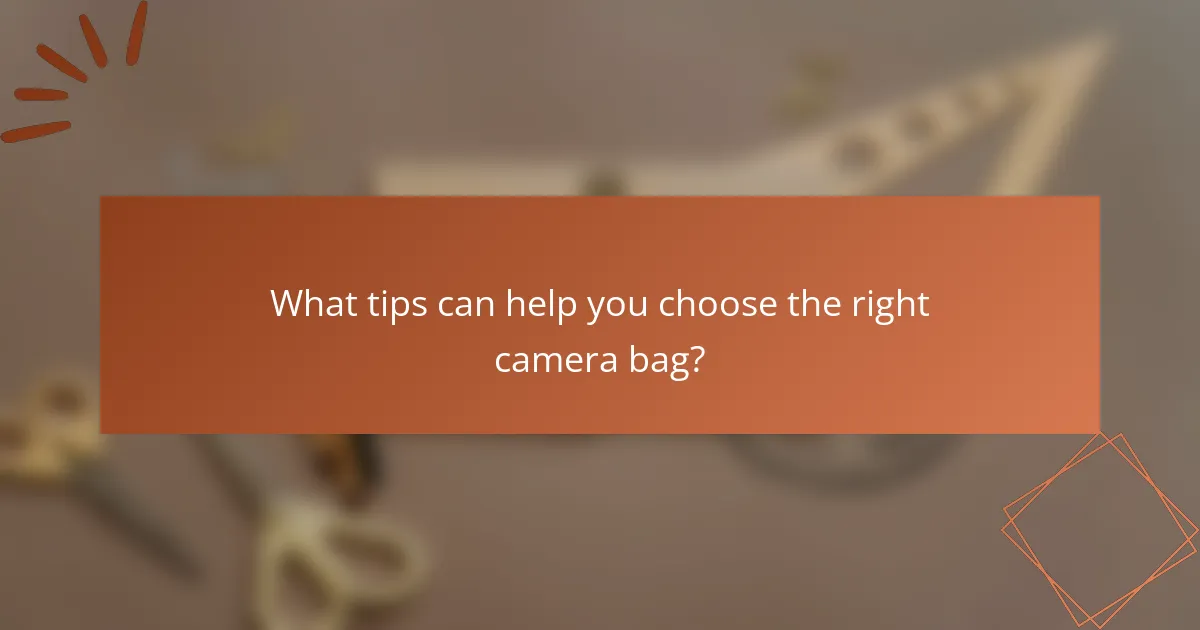
What tips can help you choose the right camera bag?
To choose the right camera bag, consider protection, size, and organization features. Protection is crucial to safeguard your camera gear from damage. Look for bags with padded compartments and weather-resistant materials. Size should accommodate your camera, lenses, and accessories without being overly bulky. Assess your typical gear load to find a bag that fits comfortably. Organization features like adjustable dividers help customize space for your equipment. Additionally, check for external pockets for quick access to small items. A comfortable strap is also important for ease of carrying. These considerations ensure you select a camera bag that meets your specific needs.
How can you evaluate your specific needs for a camera bag?
To evaluate your specific needs for a camera bag, start by assessing your camera gear. Identify the types of cameras and lenses you own. Consider additional accessories like tripods and filters. Next, think about how you intend to use the bag. Determine if you need it for travel, hiking, or everyday use. Evaluate the level of protection required for your equipment. Research shows that padded compartments can safeguard gear from impacts. Additionally, consider the bag’s size and weight. A bag that is too heavy can be cumbersome during long shoots. Lastly, look for organization features. Multiple compartments help keep gear accessible and organized.
What questions should you ask yourself before purchasing?
What questions should you ask yourself before purchasing a camera bag? First, consider what camera gear you own. Identify the size and weight of your equipment. Next, evaluate how you plan to use the bag. Determine if you need it for travel, daily use, or specific events. Assess the level of protection required for your gear. Check if the bag offers adequate padding and weather resistance. Also, think about organization features. Consider how many compartments you need for lenses, accessories, and personal items. Finally, reflect on your budget. Set a price range that balances quality and affordability.
How do you prioritize features based on your photography style?
Prioritizing features based on photography style involves assessing specific needs. Different styles, such as portrait, landscape, or street photography, require distinct equipment. For example, portrait photographers may prioritize lens compartments for prime lenses. Landscape photographers might focus on weather resistance and storage for tripods. Street photographers often need quick access and lightweight options. Understanding these requirements allows for effective feature prioritization. This approach ensures that the chosen camera bag aligns with the photographer’s unique style and operational needs.
What are common mistakes to avoid when selecting a camera bag?
Common mistakes to avoid when selecting a camera bag include not considering size and fit. A bag that is too small may not accommodate all gear. Conversely, a bag that is too large can be cumbersome. Ignoring protection features can lead to damage during transport. Many bags lack adequate padding or waterproof materials. Failing to assess accessibility can hinder quick gear retrieval. Some bags have complicated openings that slow down access. Overlooking organization options can lead to clutter. Bags with insufficient compartments may make it hard to find items. Lastly, neglecting comfort can result in strain during use. A poorly designed strap can cause discomfort over time.
How can overspending affect your choice of camera bag?
Overspending can limit your choice of camera bag by forcing you to prioritize price over quality. Higher-priced bags often come with better materials and features. However, if you overspend, you may overlook bags that offer essential protection and organization at a lower price. This can lead to a mismatch between your needs and the bag’s capabilities. For instance, a budget-friendly bag might provide adequate protection and organization without the unnecessary extras of an expensive bag. Ultimately, overspending can lead to dissatisfaction if the chosen bag does not meet your specific photography needs.
What should you avoid regarding size and organization features?
Avoid choosing a camera bag that is too small for your equipment. A bag that lacks sufficient space can lead to damage during transport. Additionally, avoid bags with poor organizational features. Disorganized compartments can make it difficult to access gear quickly. Opt for bags that offer customizable dividers. This allows for better fitting of various camera sizes and accessories. Avoid heavy bags that can hinder mobility. Lightweight options enhance comfort during extended use. Lastly, steer clear of bags that lack weather resistance. Protecting your equipment from the elements is crucial for longevity.
The main entity of the article is the camera bag, which is essential for protecting photography equipment. The article outlines key considerations for selecting a camera bag, including protection features, size compatibility, and organization capabilities. It discusses the importance of materials that enhance protection, the significance of proper sizing to prevent damage, and the need for effective organizational features to ensure quick access to gear. Additionally, it covers various bag styles and their impact on usability, as well as tips for evaluating personal needs and avoiding common selection mistakes.
